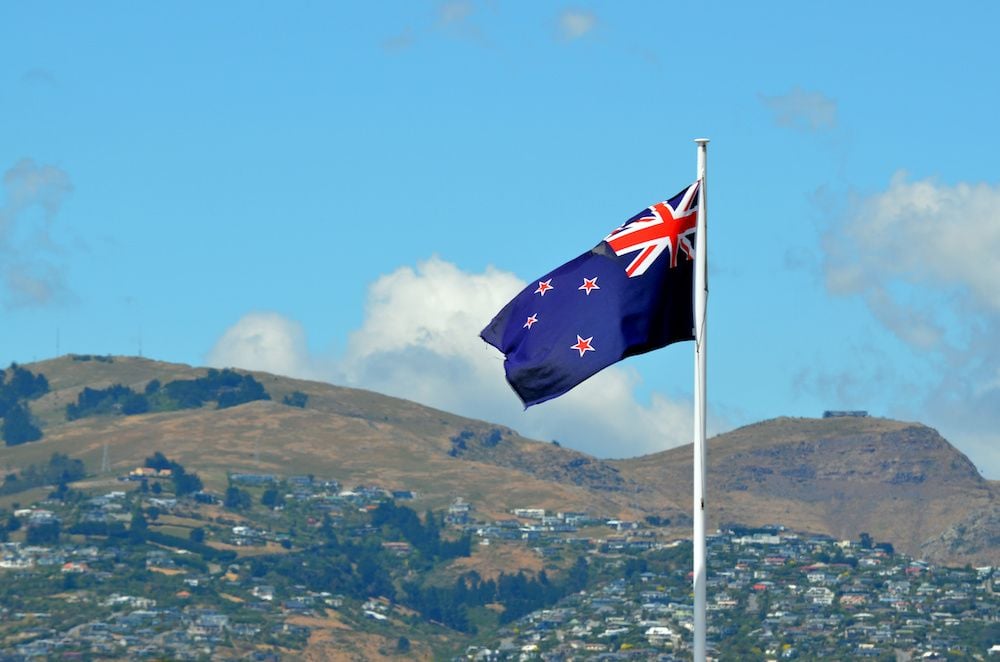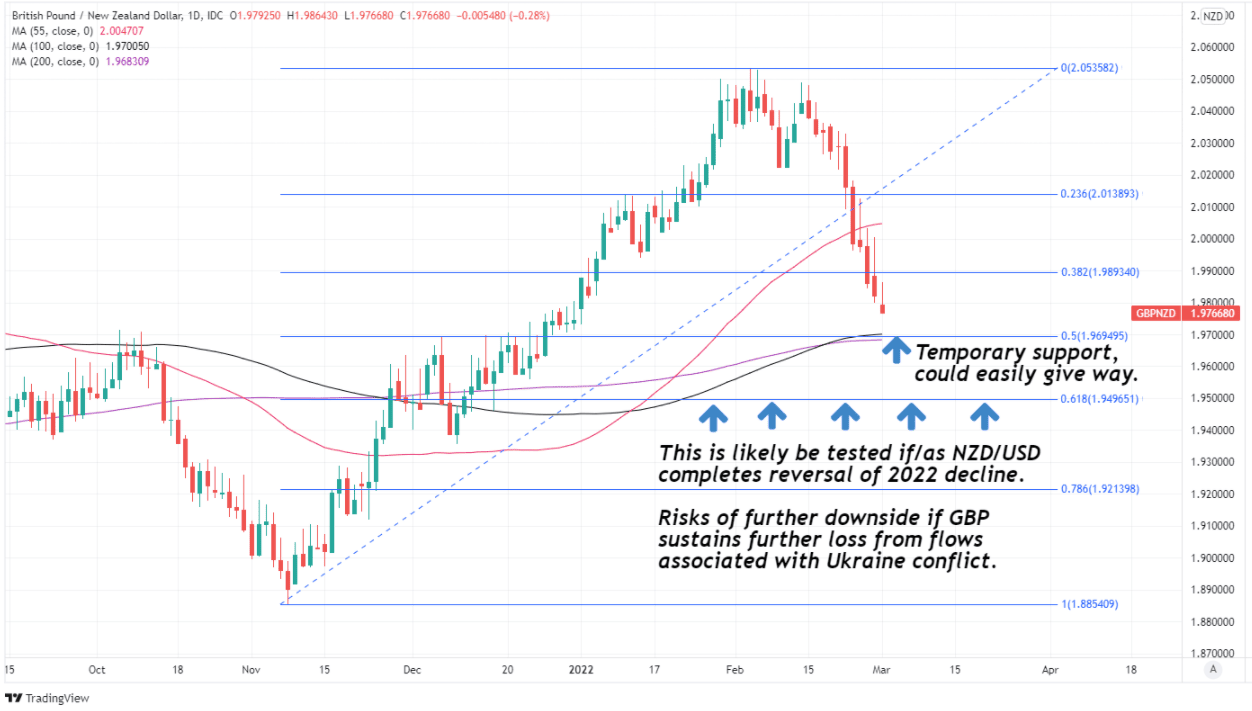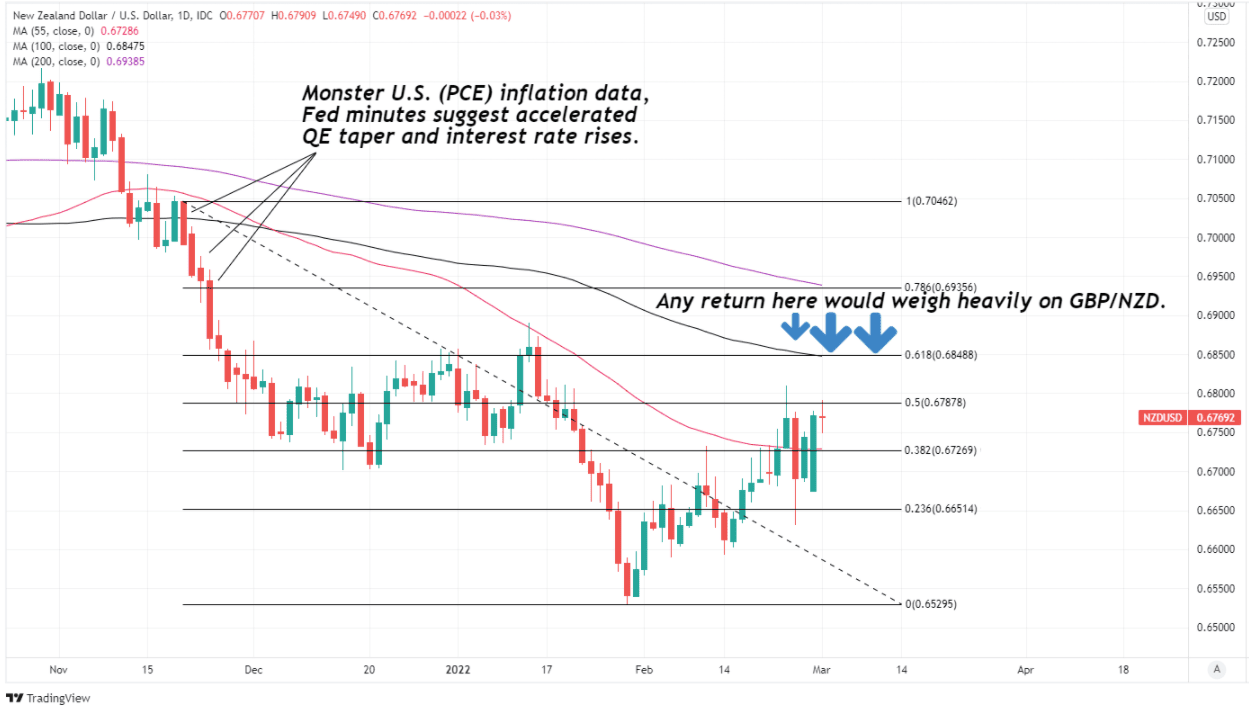Pound / New Zealand Dollar Rate Vulnerable and Could Test Below 1.95
- Written by: James Skinner
- GBP/NZD decline may have further to run
- Could see GBP/NZD probing beneath 1.95
- Commodity FX wins from Ukraine conflict
- Keeps earlier NZD/USD recovery on track
- RBNZ offering more NZD/USD upside too
- Addis further downside risk for GBP/NZD
- As GBP, EUR take heavy flak over Ukraine

Image © Adobe Stock
The Pound to New Zealand Dollar exchange rate has gone from boom-to-bust in spectacular fashion since the middle of February but likely has further to fall over the coming days, and may even have scope for at least a short-lived probe beneath the faraway number of 1.95.
Sterling was on course for its eleventh consecutive intraday decline against the New Zealand Dollar on Tuesday having recently sustained some of its largest losses since the final yards of the Brexit quagmire in late 2020.
GBP/NZD had risen significantly between early October and the middle of February only for half of this rally to unravel by Tuesday due to a noxious cocktail made up of a weakening Pound and a strengthening Kiwi.
“NZD/GBP is back above 0.50 (again) [GBP/NZD below 2.00]. Price action looks strong, but as with NZD/EUR, we’re mindful the BoE’s tone could weigh later,” says David Croy, a strategist at ANZ.
Pound Sterling came under widespread pressure again early in the new week and could remain so for as long as the Euro and other continental currencies continue to take flak over the conflict in Ukraine, which has weighed especially heavily on central and eastern European (CEE) currencies.
Above: Pound to New Zealand Dollar rate shown at daily intervals with Fibonacci retracements of November 2021 rally and selected moving-averages indicating likely areas of technical support for Sterling.
- GBP/NZD reference rates at publication:
Spot: 1.9716 - High street bank rates (indicative band): 1.9026-1.9164
- Payment specialist rates (indicative band): 1.9540-1.9617
- Find out about specialist rates, here
- Set up an exchange rate alert, here
“The path of EURUSD, and possibly the ECB's response, will probably be more heavily dominated by headline risk related to the war in Ukraine than rate differentials in the short-term,” says Stephen Gallo, European head of FX strategy at BMO Capital Markets.
CEE currencies - especially the Polish Zloty - have come under barely relenting pressure since Russian military forces entered Ukraine last Thursday, and this has appeared to be pulling the European single currency lower, with this in turn weighing heavily upon Pound Sterling.
Euro-Dollar declines have so-far elicited accompanying losses from GBP/USD, leading other areas of the Sterling exchange rate complex to fall including GBP/NZD, and it could be the case that Sterling continues to struggle for as long as the Euro remains under pressure.
“Given the downside economic risks, EUR/USD remains vulnerable to further falls to its 1.1106 support level in the near term,” says Carol Kong, an economist and currency strategist at Commonwealth Bank of Australia.
{wbamp-hide start}
{wbamp-hide end}{wbamp-show start}{wbamp-show end}
“The resilience in GBP, relative to EUR, likely reflects the smaller exposure of the UK economy to the Russia‑Ukraine conflict. This can also be seen in the still strong market pricing for the Bank of England’s (BoE) interest rate tightening cycle,” Kong and colleagues also said on Tuesday.
While the conflict in Europe and its side effects have weighed heavily on Sterling, GBP/NZD’s declines have been buttressed by a robust recovery of the New Zealand Dollar from its late January lows, which would add further to the downside in GBP/NZD in the days and weeks ahead.
The conflict in Ukraine has lifted commodity prices as well as related currencies including the New Zealand Dollar, while Reserve Bank of New Zealand (RBNZ) monetary policy has provided a significant uplift too and could yet be a source of further upside for the Kiwi.
“The Reserve Bank has significantly revised up its forecast of how high or far the cash rate needs to go. Our forecast is that the OCR will get to 3%. The RBNZ’s forecast is very similar over 2022 but then has the OCR rising to 3.35%. That’s about a 75 basis point increase in the OCR track which, as it happens, is exactly how much tightening they’ve managed to deliver so far,” says Sharon Zollner, chief economist at ANZ.
Above: NZD/USD shown at daily intervals with Fibonacci retracements of November 2021 decline indicating likely areas of technical resistance to a further Kiwi recovery. Selected moving averages denote possible support and resistance.
Secure a retail exchange rate that is between 3-5% stronger than offered by leading banks, learn more.
The RBNZ lifted its benchmark interest rate from 0.75% to 1% in a widely anticipated February 23 decision but also announced significant upgrades to its forecasts for inflation and its assumption of the level that interest rates will need to rise to in order to bring price pressures under control.
This has seen the overnight-indexed-swap market pricing-in a steep upward trajectory for New Zealand’s interest rate, although the government bond market has been slow to follow on and strategists at Westpac say this could lead NZD/USD to rise back above the 0.68 level in the short-term.
“The Ukrainian war is hurting risk sentiment, but also boosting commodity price expectations. In addition, the NZD is also supported near term by yield spreads which got a boost from a more hawkish RBNZ. But multi-month, while the NZD should retain solid fundamental backing, it is likely to again be dominated by Fed-driven USD developments,” says Imre Speizer, head of NZ strategy at Westpac.
Westpac’s Speizer said Tuesday that NZD/USD could rise to 0.6810 over the coming days, which would weigh further on GBP/NZD along the way.
The Pound to New Zealand Dollar rate tends to closely reflect the relative performance of both NZD/USD and its Sterling equivalent GBP/USD with the effect that gains in NZD/USD are a headwind that could grow quickly with any incremental losses GBP/USD.







